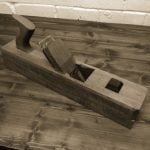Refining Spear & Jackson Saws
Welcome! / Forums / General Woodworking Discussions / Tools and Tool Maintenance/Restoration / Refining Spear & Jackson Saws
- This topic has 23 replies, 11 voices, and was last updated 4 weeks ago by
Greg Zoller.
-
AuthorPosts
-
 27 January 2020 at 5:21 pm #646676
27 January 2020 at 5:21 pm #646676Per Paul’s recommendation I have purchased some Spear & Jackson saws, both the 22″ skew back and 12″ tenon saw. After sharpening and relaxing the set of the teeth I have found both saws to be very good performers. I especially appreciate saving hundreds of dollars on my first hand saws. Many thanks go out to Paul for testing and recommending these practical yet well-performing tools.
The only complaint I have is related to aesthetics. The handle is far too chunky and the branding on the saw blade is hideous. I suppose I have two questions:
1. Has anyone refined the handles successfully and have any tips for doing so? I’ve seen videos of people making their own handles so I understand the basic concepts involved, but I’m wondering if anyone has practical experience refining the S&J handles without taking them off.
2. Is it possible to remove the branding and lacquer on the blade? If so, how? And, is it safe to do this or will doing so invite corrosion?I know aesthetics are to a degree secondary to functionality, but there is some merit in the idea that one can get more satisfaction from a tool that is both functional and beautiful.
Thanks for any advice.
-Joe
Hello Joe,
I’ve got S&J saws too and with my relatively small hands the handles aren’t comfortable.
So I started to rasp and file off the sharp edges where thumb, palm and three fingers grip.
Additionally I began to shape the rear part of the grip to develop a more accentuated “hunchback”.
But in the long run I’ll make new handles.The lacquer and the branding wears off during use of the saw anyway. Until now I didn’t notice
unusual corrosion – even on the saws where I tried to remove the lacquer with white spirit.The S&j saws are a good base to start modifying – and deliver a good reason to do so due to the
clunky handles. 😀E.
Most modern saw-makers using wooden handles halt the process somewhere before the final shaping… consequently we have what is effectively a square-profile blank. This is unintentionally useful for us who prefer a more bespoke and traditional saw handle shape. Add to that the fact that some of us have small hands and there’s a problem worth solving.
The S&J handles can, and have been, re-shaped. Unless you have a known template that suits you, it is a matter of trial and error – rasp and file, rasp and file until you get a shape that suits. Engineers’ abrasive tape, in the rough grades, can get inside the profile behind the grip better than files.
It is possible to do it without removing the handle, but personally I find that it is better to do so…. only a few screws.
So, shape the handle… use it refine it, shape it a bit more… use it…. when you have a good shape, carefully trace the shape for future conflicts then finally sand it down and oil it with linseed oil.As for the etching….. it’s part of the saw’s identity, but if it annoys you, take some wet and dry emery paper and do the whole blade (with the handle off!).
The next step will be to make your own handles. Not at all difficult once you have established a good usable profile for your hand.
Traditionally in the UK, it’s Beech, or (my own preference) Apple-wood. 29 January 2020 at 8:35 pm #646954
29 January 2020 at 8:35 pm #646954Fortunately the handle has enough ”meat” so you can reshape it to suit your hands and aesthetics. I have done some reshaping on my S&J tenon saw (my first ever attempt to reshape a saw handle, so the result is not impressive). I removed the handle from the saw, striped the finish, reshaped, finished with boiled linseed oil and replaced the rivets with proper brass saw nuts. I think that you can do it without removing the saw plate though. Just take a pencil, draw the new shape on the handle (if you don’t like it erase it and try again) and then remove the excess wood.
If you want to remove the lacquer and the branding from the plate try methylated spirit, it worked for me (I have tried white spirit wihout any success first). After 3-4 years in my damp garage I have no rust problem without the lacquer coat, I just wipe the plate with an oil rag after use.
You may also polish the brass to a mirror finish if you like.
Attachments:
You must be logged in to view attached files. 30 January 2020 at 1:43 pm #646999
30 January 2020 at 1:43 pm #646999Ecky,
The handles are definitely my main complaint, even though the solid beech is a positive aspect. I have large hands and while I can comfortably hold the saw correctly during use, I’ve used Disston saws in the past and the feel in the hand is night and day. I agree that ultimately a new handle is the way to go.
Vielen Dank!
 30 January 2020 at 1:59 pm #647000
30 January 2020 at 1:59 pm #647000YrHenSaer,
I’m going to keep your advice about progressive adjustments in mind. My personal tendency is to try to fix things immediately to a final state, when in this case the better approach is to go at it incrementally and get a truly custom fit.
When you’re referring to abrasive tape, do you mean a product like this:
https://www.leevalley.com/en-ca/shop/tools/supplies/sanding/accessories/20181-abrasive-cords-and-tapesSomeday I’m going to take a crack at making my own handles. Like you I think I’d prefer a fruitwood handle and I think I have a plan for that. I’ve got a large, out of control Bradford Pear tree on my property that I’m going to try to harvest. I’m hoping to get some decent handle-worthy blanks as well as maybe some wood for furniture and maybe mallets.
Thanks for your advice…greatly appreciated.
 30 January 2020 at 2:04 pm #647001
30 January 2020 at 2:04 pm #647001Dionysios,
Thanks so much for the photo! Your refined handle looks great and this will help me a lot as a point of comparison. That’s a darn good looking handle given what there is to work with when the saw arrives. Thanks for the tip on methylated spirits as well.
31 January 2020 at 9:49 am #647097Yes that handle looks great – what a huge improvement! Thanks Dionysios.
I’m inspired to try the same thing on my S&J saw. Can anyone advise the best way to remove the rivets, without damaging the handle?
 31 January 2020 at 12:19 pm #647117
31 January 2020 at 12:19 pm #647117The easier way to remove the rivets is drilling them out.
Mark the centre of the rivet cap with a centre punch, so that your drill bit won’t slip and damage the handle, and then drill through the rivet cap.
You may try a small drill bit, say 3mm, at first and then use a larger one to cut completely the rivet head.
It’s easier if you drill the female part of the rivet, which, if I remember well, on my saw was on the side of the handle with the S&J logo.
 22 February 2020 at 11:52 pm #650193
22 February 2020 at 11:52 pm #650193So, I took a crack at refining the handle of the 22″ panel saw. The results are far from perfect but appearance aside, the handle feels much better in my hand. I did not take the handle off the blade when I worked it, though I agree with the commenters above who noted that removing the handle would make the job easier. I opted not to do this because, well, one thing at a time. Perhaps in the future I will replace the rivets with proper saw nuts.
I patterned the refinement on a Disston saw that I own which feels terrific in my hand. See the photos for the pattern Disston, refined S&J, and a stock S&J side-by-side for comparison’s sake. I wasn’t able to replicate the pattern as well as I wanted to, but I’m reasonably happy for a first attempt. I freehanded guide lines with a pencil and then shaped using a rasp, saw, chisel, and sandpaper at various stages of the process.
A few things I learned:
-Simply easing the hard edges with a rasp followed by sandpaper makes a huge difference in the way the saw feels in the hand. If anyone is looking for a quick and effective improvement, that’s a good place to start.
-The other big ‘feel’ improvement was modifying where the hump on the back of the handle hits the palm. I’ve had trouble with my hand hurting with this saw when I do a lot of sawing in one work session, and what I discovered was that altering the hump so it hits lower in the palm makes a big difference. You can feel the difference just holding it.
-If you go whole hog and make aesthetic improvements to the shape, one commenter above suggested engineer’s tape would be helpful, and I would agree. A coping saw would be nice if you add a notch inside the handle as I’ve done. I have neither, so I used a chisel, rasp, knife, and sandpaper, which worked but added difficulty.If anyone follows Paul’s blog you’ll note that he recently posted write-ups on refinement and replacing saw nuts on the stock S&J handles. He made different adjustments to the handle and they look excellent. I refined my handles before Paul posted his, and in a way I’m glad I did because the design is my own, the results are my own, and the saw is custom fit for my hand. Paul’s workmanship is better than mine (no surprise there), and his write-ups are invaluable guidance. But there is something to be said for adapting his concepts for personal satisfaction.
[attachment file=”650194″]
[attachment file=”650195″]
Attachments:
You must be logged in to view attached files. 26 March 2020 at 8:45 am #654563
26 March 2020 at 8:45 am #654563I also refined my 22” 10pt S&J, really happy with it post surgery. It took me two pretty full evenings to shape and another few short sessions here and there with shellac – not exactly a 5 minute job! But I’m much happier with the feel now.
I used a 20mm no 3 gouge quite extensively, both ways up – it cut the beech like butter with hand pressure only (new Stubai, steel seems great btw).
I was surprised by how much material I removed under the upper horn to get a comfortable shape – took 3 passes at it, as I was so nervous of overdoing it.
Now to face up to sharpening it, my first crosscut …
-
This reply was modified 4 years, 4 months ago by
Andrew Sinclair.
Attachments:
You must be logged in to view attached files. 3 April 2020 at 6:05 am #655571
3 April 2020 at 6:05 am #655571[quote quote=646676]Per Paul’s recommendation I have purchased some Spear & Jackson saws, both the 22″ skew back and 12″ tenon saw. After sharpening and relaxing the set of the teeth I have found both saws to be very good performers. I especially appreciate saving hundreds of dollars on my first hand saws. Many thanks go out to Paul for testing and recommending these practical yet well-performing tools.[/quote]
What size saw files did you use to sharpen the Spear and Jackson saws?
Joe, Without getting into the geometry and sizes of the gullet, the basic method of selecting the appropriate file for a particular saw-tooth size is to concentrate on the width of the file – the length is secondary and determines in large part the aggression of the cut.
Look at your saw: the files are equilateral triangles in section and so is the basic shape of the tooth.
Because the tooth has a rake angle (it’s pointing forward to the toe of the saw) the back of the tooth is longer from the gullet to the tip than the front. Therefore, the most economical file size will be one one that has a side width that is one or two millimetres greater than twice the length of the back of the tooth. This means that you can use both edges of each face of the file and leave the minimum unused space in the middle.Simple as that.
Wider files than you need will tend to give misshaped teeth in relation to their gullet-size because the bigger saw-files get, the greater the radius of the curve on the gullet.
-
This reply was modified 4 years, 4 months ago by
-
AuthorPosts
- You must be logged in to reply to this topic.
